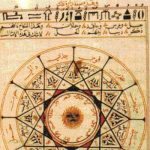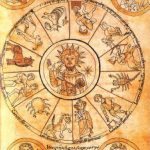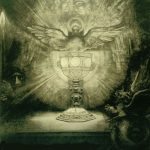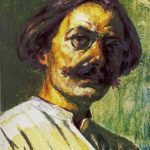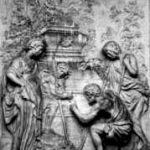Chapter Eight
In the divinely rebuilt New Jerusalem, as we saw in John’s Revelation, The Tree of Life will stand on the banks of the river of the waters of life. This suggests that the new heaven and the new earth promised to John would in fact be a return to the Garden of Paradise. The Chilaists thought so, and saw in this divine re-creation a chance to indulge in the innocent joys of a purified humanity. They quite naturally assumed that, since the re-created Paradise had no Tree of the Knowledge of Good and Evil, the original cause of the fall of man into sinfulness, there could be no such thing as sin in the New Jerusalem.
Origen and the other fathers of the orthodox church disliked this interpretation, of course, but even they could not completely remove the idea of a transformed reality, complete with a transformed body, from the orthodox eschatology. The Gnostic concept of matter redeemed or animated by an apocalyptic event, the sparks of light returning to The Light, remained at the heart of the official orthodox apocalypse.
Christianity emerged from the political turmoil of 1st century Palestine, a truly apocalyptic moment in Jewish history. Christianity did not become a universalist religion until after the End of the World for the Jews. Six and a half centuries to the day after Nebuchadnezzar’s armies destroyed Solomon’s Temple, Roman forces under the soon-to-be Emperor Titus sacked and burned the Temple of Herod. This was an End of the World far greater than the Babylonian Captivity. Cyrus the Great allowed the Jews to return from Babylon after a generation or so. The New Babylon on the Tiber never allowed the Jews to return. One thousand eight hundred seventy eight years, and many more apocalypses, would pass before a Jewish nation returned to Palestine.
We saw how Christianity slowly became an orthodoxy and then, miraculously, the Imperial religion of the hated Romans. By the late sixth century, when Imperial Orthodoxy was firmly in the driver’s seat of the Roman military machine, Judaism was the only tolerated non-orthodox form of religion. This does not mean that the Roman Christians saw the Jews as equals — it was against the law to intermarry and for Jews to own real property such as land — but they were at least accepted as serving a useful function in society, as scapegoats. Since the Christians could no longer blame the Romans for Christ’s death, the blame shifted to the Jews, creating the basic rationalization for a thousand years of Christian persecution.
After the fall of the Temple, the largest Jewish communities centered around Alexandria in Egypt and the old city of Babylon in Mesopotamia. A few Jewish communities remained in Palestine, mostly notably the spiritual community at Saafid, near Tel-Aviv, on the eastern shore of the Mediterranean. The mystical Jews of Saafid would retain their foothold in the Holy Land right down to the 20th century.
But other than this, the Jewish people were dispersed throughout the Roman Empire, and in the east, far beyond it. This gap between the western Jews and those in the East eventually became the two broad currents of Judaism, Sephardic and Ashkenazi. In the early centuries of the Dispersion, Jewish culture and religion re-formed itself. The portable Tanakh, the books of scriptures, (The Torah, the Nevi’im and the Kethuvim are the three major divisions, hence the name TaNaKh) could travel with them. It became the centerpiece of every synagogue, and in many ways, took the place of the Temple.
The Tanakh is recognizable to Christians as the Old Testament, having assumed its final form less than fifty years after Jesus’ birth. The core of the Tanakh is the Books of the Law of Moses, the Torah. This is essentially the same as the work read to the crowd before the restored Temple in 587 BCE. The Nevi’im are the works of the prophets, which developed alongside the later versions of the Torah, but were added to the canon a few centuries later. Kethuvim, or writings, are the extra scriptural books that do not fall under either category. These contain some of the last works added to the canon, such as The Song of Songs attributed to Solomon.
In the centuries after the Dispersion, commentaries of various rabbis on the Tanakh, known as the Talmud, attained an importance second only to the Torah. Along with these evolved several collections of the sayings of the sages, known as the Midrash. Finally, The Mishnah, or legalistic texts interpreting various points of scripture for the Jews of the Dispersion, developed in response to the problem posed by the absence of the Temple.
Unlike Christianity, which denounced its mystical origins as heresy, Judaism retained a powerful connection with those same mystical roots. Our earliest alchemical text, “Isis the Prophetess to her son Horus,” points to an Egypto-Hebraic source for its transformational philosophy. Interestingly enough, a Hebrew contemporary of the author of the “Isis the Prophetess” story, Rabbi Nehuniah ben HaKana, revealed to his students the magickal technology behind these transformational processes. In the later centuries of the Dispersion, his teachings would form the basis of the traditional Kabbalah.
Compared to the anonymous author of “Isis the Prophetess,” Rabbi Nehuniah ben HaKana was a well known and respected Jewish sage. His few mentions in the Talmud leave no doubt about the important position he occupied in the early Talmudic era. His mystical teachings inspired a whole generation of Jewish sages. However, from the perspective of our inquiry into the origins of alchemy, his importance lies in his authorship of the teaching document known as The Bahir.
The oldest and most influential of all Kabbalistic texts, The Bahir, or The Illumination, (from Job 37:21 — “And now they do not see light, it is illumination (bahir) in the skies.”) was also called the “Midrash of Rabbi Nehuniah,” to emphasize his authorship. This is unusual, since Rabbi Nehuniah is quoted only once, in the first verse. However, a Rabbi Amorai, perhaps a pseudonym for Rabbi Nehuniah, is sited nine times. Amorai means “speakers,” and indicates that he was the spokesman of a committee or group of sages. If this was Rabbi Nehuniah, then he must have felt he was speaking for the whole tradition, as well as his immediate group.
This could well be the case. Around the time of the completion of Herod’s Temple, a young Rabbi Nehuniah joined the school of Rabbi Yochanan ben Zakkai, even though he was already an ordained Rabbi. Nehuniah had come to learn the mystic arts of the work of creation from the acknowledged master of the age.
Rabbi Yochanan ben Zakkai was born before the construction of Herod’s Temple, lived to see the destruction of that Temple and finally became the leader of the early Dispersion era Jews. He was a renowned expert in the occult arts, particularly that of the work of creation, the oral teaching that would become the Sepher Yetzirah under Rabbi Akiva in the second century CE. This oral teaching contained nothing less than the secret of animating matter, the transformative process at the heart of alchemy.
According to tradition, Abraham learned these secrets from Shem, the son of Noah, also known as Melchizedek, The Righteous King of Ur and Salem, thought to be Jerusalem. The most important mysteries of the work of creation concerned the significance of the letters of the Hebrew alphabet and their relationship to astrology and the mysteries of the calendar, or time itself. Attributing this wisdom to Abraham and Melchizedek places its origin in the 18th century BCE, the time of the rise of the New Kingdom in Egypt as well as the Vedic scholars of India. Abraham was considered to be the greatest magician and astrologer of his age. The Talmud tells us that “all the kings of East and West ( Egypt and India) arose early (to wait) at his door.” The teachings of the work of creation are one of the primary ancient astrological texts and incorporates the astrological wisdom Abraham was said to have known “in his heart,” that is, revealed to him through meditative or magickal means.
The secret work of creation is mentioned several more times in the Torah. Jacob and his sons, including Joseph, were adepts of the work. After the Exodus, the Israelites called upon the architect Betzalel, who “knew how to permutate the letters with which heaven and earth were created,” to build the Tabernacle in the desert. The Tabernacle needed to be a microcosm of the universe, a physical container for the hermetic idea of “as above, so below,” and only a knowledge of the work of creation could achieve this.
Jeremiah, the prophet of the Babylonian Captivity was also an adept of the work of creation. From his teachings on the subject arose the traditions that would evolve into the Sepher Yetzirah as taught by Rabbi Yochanan in the early first century CE. The oral teachings on the work of creation received by Rabbi Nehuniah from Rabbi Yochanan originated in the early years of the Second Temple, the late 6th century BCE, and as such are as much a part of Judaism as the Hebrew prayer service which developed at the same time and was also not put into writing until much later.
The Sepher Yetzirah is mentioned in the Talmud. The first such reference involves Rabbi Yehoshua ben Chananya, and credits him with the statement: “I can take squashes and pumpkins, and with the Sepher Yetzirah, make them beautiful trees. These will in turn produce other beautiful trees.” This echoes the statement in the “Isis the Prophetess” story: “Only Nature can overcome Nature.”
The reference to Rabbi Jehoshua is highly significant. He was a disciple of both Rabbi Yochanan and Rabbi Nehuniah and is therefore a connecting link between the schools of the Sepher Yetzirah and The Bahir. There is an interesting Midrash from “The Chapters of Rabbi Eliezer” in which the young Jehoshua astounds the leading scholars of the day and is acclaimed a Rabbi in spite of his age. Since Jehoshua, Joshua, is Jesus in Greek, we find here a faint echo of Luke’s tale of the young Jesus amazing the elders of Temple (Luke 2: 41 -51). In his citations in the Talmud, Rabbi Jehoshua also appears to be similar to the image of an aristocratic Jesus given in the Gospel of Matthew.
In addition to studying the work of creation with Rabbi Yochanan, Rabbi Nehuniah went on to study the other major current of Jewish mysticism, the Work of the Chariot, with the Essene Menachem, a former High Priest of the Temple and deputy of the Sanhedrin, or supreme council, under Hillel. Menachem is the Essene teacher mentioned by Josephus, the great Jewish traitor and apologist historian of the Fall of Jerusalem. As a child, Menachem had seen Herod and prophesied that he would be king. Herod remembered this, and placed Menachem and the Essenes in honored positions at his court.
Josephus tells us that the Essenes were skilled in angelic magick and could foresee the future. He also likens them to the Pythagoreans. Indeed there is much that is similar in both the Bahir and the Sepher Yetzirah to the teachings of Pythagoras. Rabbi Nehuniah, master of the mystic arts in first century Palestine, served as the junction point where all the major currents of Hebraic and classical magick intersected and interacted. The result of this eclecticism can be seen in the brilliance of the Bahir.
Although the Bahir is the primary text of the Kabbalah, it does not use that term. Kabbalah, from the Hebrew root QBL meaning received or given, came into fashion much later when the teachings of the first century mystics were indeed just “received traditions.” The sages of the Bahir preferred the more ancient term Maaseh Merkabah, literally “Workings of the Chariot,” with its connotations of active mystical experience as opposed to received tradition. The Bahir combines the ideas of the work of creation, animating matter, with the radical concept of celestial projection as a way to return to the divine source. By juxtaposing these ideas, The Bahir reveals the secret at the heart of alchemy.
The key concept is the Tree of Life, Etz Chaim, described in the work of creation traditions. The Bahir adds an important point to the discussion by suggesting that portions of the celestial sphere can be equated with the spheres of each sepherot, or globe, on the Tree of Life. In verses 179 and 180 of the Bahir we learn that our physical world “is like a mustard seed in a ring.” In a sphere around the ring are the ten spheres and their animating statements, which verse 180 locates in space around a center point, supposedly the mustard seed.
This of course suggests the parable of the mustard seed found in Matthew 13: 31-33 and Mark 4:30-32. “The kingdom of heaven is like a mustard seed which a man took and planted in his field. Though it was the smallest of seeds, yet when it grows it becomes a tree, so that the birds of the air come and perch in its branches.” In Matthew, Jesus goes on to relate the parable of the yeast, a metaphor for the kingdom of heaven as a transformative force that spreads throughout all matter. Matthew ends the section with another quote from 2nd Isaiah explaining why Jesus spoke in parables: “I will open my mouth in parables. I will utter things hidden since the creation of the world.”
This also suggests the Talmudic saying of Rabbi Jehoshua mentioned above, where garden vegetables are transformed into trees by the work of creation. Since Rabbi Jehoshua studied with Rabbi Nehuniah’s mystical group, we can also suppose that he understood the metaphor in the same way as the sages of the Bahir did. From this we can see that Jesus, who ever he was, was indeed revealing “things hidden since the creation of the world.”
Verses 63, 95 and 106 of the Bahir, describe the Tree which grows from this mustard seed in terms of the ancient ideas later written down in the Sepher Yetzirah and the Sepher Zohar. Here, the emphasis is on an esoteric and practical application of these ideas. In verse 63, we find the revelation of the Thirty Two paths of the Tree of Life coupled with a strange story of a king’s secret chambers and his love for a daughter who is also his sister and his mother. Since 32 is the number of the heart (leb in Hebrew), the verse suggests looking to the heart as a way to go inside the hidden chambers.
We must remember that works such as the Bahir were written for the initiated few who could understand its complex metaphors. If we take it literally, we are sure to misunderstand its meaning. Verses 95 and 96 of the Bahir make this quite apparent.
Attributed to Rabbi Amorai, the spokesman for the traditional viewpoint, verse 95 reveals the structure of the Cube of Space and the jewel of the celestial Tree within it. This structure is based on the ancient concepts of the Axis, the Sphere and the Heart. If we know the secret, then this is one of the most straightforward verses in the Bahir. Without the key however, it is merely an incomprehensible string of numbers.
The first three verses of the sixth chapter of Rabbi Akiva’s Sepher Yetzirah supplies the key, although in a truly oblique fashion. The first verse informs us that as proof of the existence of the Tree of Life, the twelve, the seven and the three, “He set them in the Teli, the Cycle and the Heart.”
The secret lies in the mysterious word Teli. It occurs in neither the Torah nor the Talmud, although it is used in the Bahir. There is considerable dispute among scholars as to its precise meaning. The only similar word in the scriptures is a single reference to some kind of weapon in Genesis. Apparently, from the root of the word, talah or to hang, it must have been some kind of bolo, or a weight suspended on a rope for throwing. This suggests that the celestial axis around which the heavens rotate is a kind of imaginary string from which the celestial globe hangs.
But what is it hanging from? An ancient Midrash, “The Prayers of Rabbi ‘In The Beginning,’ ” tells us that it “hangs (by a thread) from the fin of the Leviathan.” This ancient serpent is nothing other than the constellation of Draco, the Pole Serpent mentioned in Job 26:13 — “By His Spirit the heavens were calmed, His hand pierced the Pole Serpent” — and in 2nd Isaiah 27:1 — “On that day (the day of judgment) with His great sharp sword, God will visit and overcome the Leviathan, the Pole Serpent, and the Leviathan, the Coiled Serpent, and He will kill the dragon of the sea.” Note that three such dragons are mentioned here.
To understand this, we must look up at the stars. We can all find the Pole Star, Polaris in the tail of Ursa Minor, the Little Bear. This marks our north celestial pole and is directly above the north pole of our planet. There is another pole in the sky however. This the pole of the solar ecliptic, the path of the sun through the constellations. The earth is tilted on its axis against the ecliptic, so that the celestial pole above our planetary pole describes a great circle in the sky over time. In 4500 BCE, Thuban, a star in the tail of Draco, marked the celestial pole.
The ecliptic pole however does not change, since the path of the sun through the sky never changes. Around this point, which has no star visible to the naked eye to mark it, the constellation of Draco, the Great Dragon, spirals through all of the zodiacal signs, with the stars appearing to hang, talah, from it. Draco thereby becomes the Teli, which the Sepher Yetzirah in chapter 6:3 tells us, is “over the universe like a king on his throne.” This is perhaps an echo of an ancient form of worship, that of the God Most High identified with Baal, that predated the arrival of the Hebrews in Palestine. It is also the serpent of the garden, climbing its way up the Tree of the Knowledge of Good and Evil, the brazen serpent used by Moses in the wilderness and even Hermes’ caduceus staff.
The Gnostic Ophities, who worshipped the serpent for giving us freedom from the Demiurge and thought that Mary Magdalene was one of the founding women of alchemy, formulated the image of a snake spiraling around an egg. In simple terms, this is the serpent of Draco coiled around the elliptical circle made by the celestial pole. The image expands however when we think of the egg as the celestial sphere and the serpent as the spiral connecting the projected spheres of the Tree of Life. The Teli here would be the axis of the ecliptic poles through the head and tail of the dragon at Keter and Malkut, and the center of the celestial sphere. This is the first dragon, the Pole Serpent.
There are however two other ways to interpret the dragon-axis of the Teli. Hebrew astronomers used the term Teli to denote the inclination of the orbit of a planet from the ecliptic. In the case of the moon, this allows you track eclipses, since eclipses occur only when the sun and moon arrive at the nodes, the head and tail of the dragon to the ancient astronomers, at the same time. Solar eclipses were seen as occasions where the dragon caught and swallowed the sun for a period of time. The concept of ascending and descending nodes, the head and tail of the dragon, or Teli, is also used with the other planets. The major nodes for the sun are the vernal and autumnal equinox, the point where the celestial equator crosses the ecliptic. This is the Coiled Serpent.
And there is still another way to look at the concept of the Teli. If we think of the Milky Way as the Leviathan, then the Teli, or axis of the dragon of the sea, our third dragon-axis, then becomes the galactic axis, running through the ecliptic from Sagittarius/Scorpio to Gemini/Taurus. Like the ecliptic axis, the galactic axis is constant and unmoving. Within these pillars, or perpendicular axis, the coiled dragon of the equinox, the crossing point of ecliptic and equator, spins slowly backward through time, one degree of arc every 72 years.
A Talmudic example makes this even clearer: “The stormwind hangs (talah) between the arms of God like an amulet.” The hanging is of course the Teli, the axis of its suspension. The stormwind is the slowly backward turning spiral of the equinoxes and a metaphor for the mystical experience itself. The arms of the universe are the unmoving Teli, the ecliptic and galactic axis, from which the initiatory spiral of the equinoxes is suspended like an amulet.
The Bahir, in verse 106, announces that the Teli is nothing but “the likeness before the Blessed Holy One,” or the face of God. And then the Bahir quotes the Song of Songs 5: 11 — “His head is a treasure of gold, his locks are hanging, black like a raven.” It is somewhat shocking to find the Teli refereed to an image that is so suggestive of alchemical motifs. But, as we will discover later from Fulcanelli, these are indeed very important symbols.
Verse 96 of the Bahir addresses other key alchemical symbols, and may in fact be our earliest mention of that medieval alchemical standard, The Philosopher’s Stone. It begins: “What is the earth from which the heavens were graven (created)? It is the throne of the Blessed Holy One. It is the Precious Stone and the Sea of Wisdom.” The verse continues to suggest the spiritual value of the color blue, the traditional color of kingship, by associating the sea with the sky, and the sky with the higher light coming from the Throne of Creation.
From the Bahir, we learn that the Tree of Life is actually the Precious Stone whose facets are projected onto the celestial sphere and which is part of the continuous flow of the Sea of Wisdom. John’s Revelation is a version of this, with the Tree of Life on the banks of the flowing river, deep inside New Jerusalem’s Cube of Space.
But what did in fact happen to the Tree of Knowledge? Is it banished from the perfected schema? The Bahir suggests, in many subtle references, that the Tree of Knowledge forms itself round the axis of the celestial pole, whose Teli or dragon-axis would be the backward spiraling axis of the equinox. The celestial pole, as it circles around the fixed point of the ecliptic pole, first leans in toward the angle of the galactic axis, that is toward the center of the galaxy, and then moves away in a large precessional cycle. The timing of the Fall, when the Tree is tilted away from the galactic axis, and the timing of the resurrection and redemption, the arrival of the kingdom of heaven when the Tree tilts toward the galactic axis, is regulated by the cycles of the intersecting Teli.
The whirlwind, sufah, of our Talmudic reference is the mystical experience of the galgal, or cycle, of the Tree of Knowledge. The galgal is also spoken of in the Bahir as a womb, that is a cycle of time in which the future is born. All of time happens within the Sphere defined by the Teli, and, the Bahir tells us, is revealed in the Heart of Heaven. This is both our own personal spiritual center, the heart, and the heart of our galaxy, pulsating in harmonic fractals of the same wave.
Rabbi Nehuniah and his followers developed a complex system of illumination based on a deep understanding of the cycles inherent in the three Teli of the projected Tree of Life, the Precious Stone of the celestial sphere. The good Rabbi himself died or disappeared around the time of the destruction of the Temple in 70 CE, but his students kept the work going until late in the 2nd century. After that point, the teaching of the Bahir went deep underground for a thousand years. In the late 12th century, a manuscript version began to circulate among the Jewish mystical community of Moslem Spain.
Two hundred years later, a Parisian bookseller would find an illustrated copy of the Bahir and come to Spain in search of its meaning. With the help of an elderly Jewish sage, he would rediscover the inner secret of alchemy and the nature of time. Nicholas Flamel was perhaps the most famous and believable of all historical alchemists, and it is hard to deny that he found a transmutational secret of great value.
What happened to the secret during the thousand years it was lost to the west? The answer is simple: What the orthodox Christians and the legalistic Jews rejected, the gnostic Sufis of Islam embraced. One possible derivation of the word Sufi, in fact, comes from sufah, whirlwind, meaning those who have experienced the illuminating whirlwind of the cycle of time. Within the framework of the apocalyptic religion of Islam, the ancient wisdom survived, and true to the process itself, was transformed.
More Articles from Sangraal.com:
Submit your review | |


